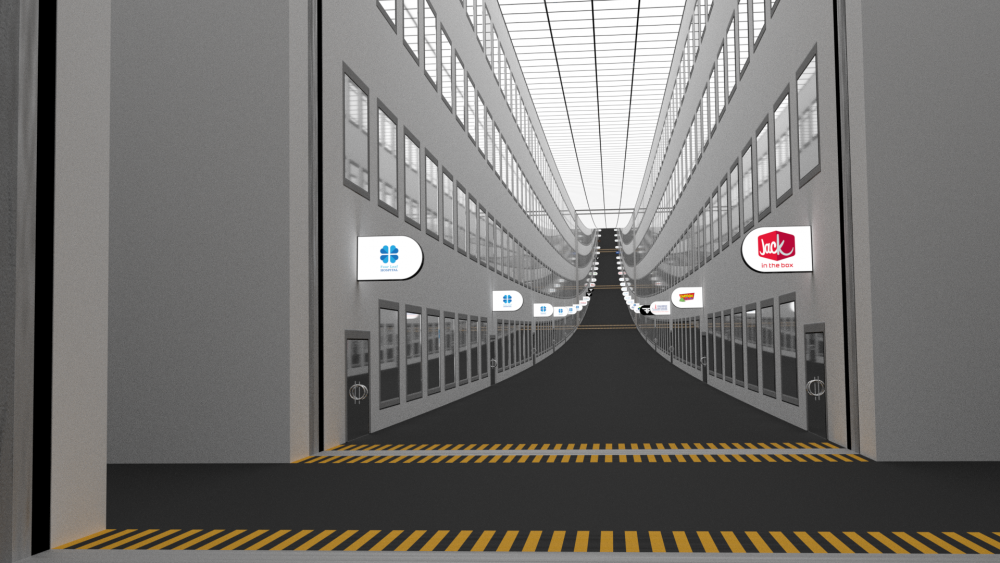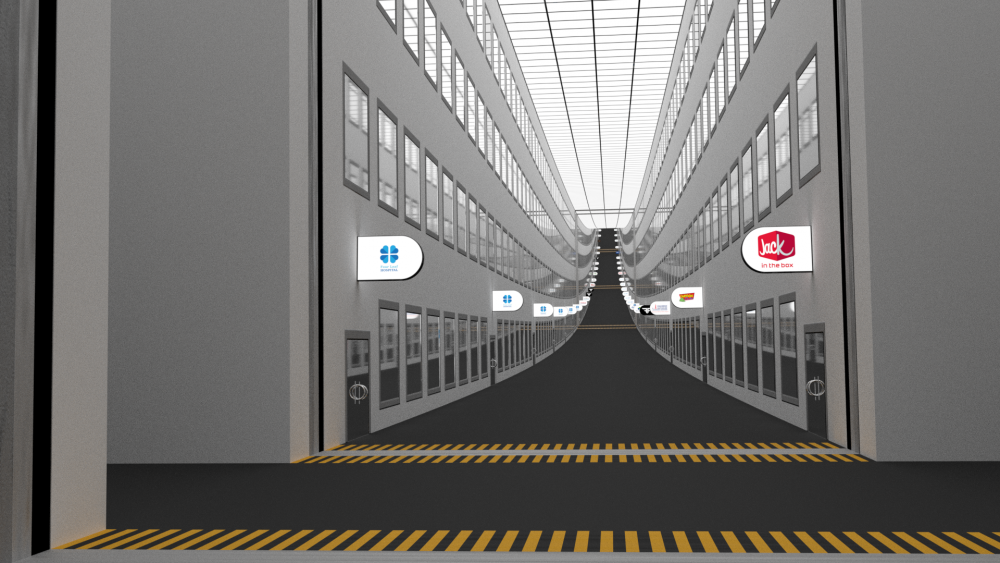-
Posts
98 -
Joined
-
Last visited
Profile Information
-
Favorite Area of Science
Terraforming
Recent Profile Visitors
5910 profile views
3blake7's Achievements

Meson (3/13)
2
Reputation
-
Attached is an image I made in Blender, of the first floor of a 2.8 km diameter space station. It has two rings spinning in opposite directions. It has enough space for hydroponics to support a population of 500,000 with an above average living space for each person. I'm still a noob at 3d modelling. For this image I wrote a Python script that generated everything. I even found over a thousand corporate logos, separated them into categories and did a random and realistic distribution.. lol. The shaders need some tweaking to improve realism.
-
3blake7 changed their profile photo
-
I am an IT professional and a huge SciFi fan. I started working on worldbuilding a science fiction universe that I believe is scientifically plausible, while trying to include any inevitable technologies and capabilities and avoiding theoretical physics longhots like negative energy, artificial gravity, wormholes and warp drives. I've been learning to 3D model in Blender and working on making a 3d animated series for YouTube. I wanted to show viewers a future that might actually be possible instead of the scientific surrealism of Star Trek or the many other SciFi universes that have one more more elements that are definitely not possible that bring their entire house of cards down. Maybe I'm being too ambitious. Why not do a REAL 1000 year plan and promote it through the arts? I could whip together a social network/project management site. My first 3d animation: https://www.youtube.com/watch?v=fThRnJguVT0 This is a timelapse of Mars being terraformed. I made a spreadsheet to do the ballpack calculations: https://docs.google.com/spreadsheets/d/1gXUkVvdsvDMAcoRa-QjDw633MYGjqjJW5h6VEpKy-30/edit?usp=sharing Long story short, to terraform Venus and Mars within a reasonable time, around 1000 years, we would need viable fusion power and an autonomous self-replicating industry. I think self-replicating systems is an inevitable capability, humans are after all, extremely complex and can self-replicate. It's only a matter of time til our own technology achieves that level of sophistication. The future could be, millions of species of nanomachines, self-replicating, spreading through the entire crust of the Earth, assembling themselves into nano-miners, nano-refineries, material transport systems, nano factories, and every type of power generation using fossil fuels, fissile material and even nano-scale fusion reactors. The automated industry could mine every useful element and add it into circulation and recycle everything. Then a citizen could log into the virtual reality with all 5 senses, talk with their personal artificial intelligence, then the AI can design them something. An hour later, the dirt in their backyard begins moving, and a super-advance self-repairing, nanotechnology based motorcycle rises out of the ground. The subterranean nanomachine industry could even infect all plant life, modify it's leaves, and siphon off solar energy. We could have a completely hidden industry. We would want to create every possible variation of technology using as many different elements and use the elements in the most efficient way overall to maximum the population and/or quality of life. AI and supercomputers might become too hungry for electricity, but we could also move them out into space, send them data, they analyze it and send the results back to Earth. We could also do subterranean cities, floating cities, underwater cities, millions of space stations along with the terraforming of Mars and Venus. We will also be capable of doing immortality. I've been researching how the brain works and I'm not 100% sure it's possible but we might be able to do mind backups and mind transfers. We would probably need to invent thousands of different species of nanomachines, like one specifically designed to locate dopamine receptors, then inject them, wait long enough for the entire brain to be "scanned". Not sure how long it would take, probably be slow, since you are limited to how many nanomachines you can have floating around the brain before causing problems. Once a mind is digitized, you could upload it into the virtual world, make a backup, transmit it to another star system or download it into an android or genetically engineered body. The modified human body, could have immortality, faster regeneration, and a modified brain that makes mind uploads/downloads easier. I came up with a memory density that doesn't break the laws of physics, and we could easily fit a human mind, every single particles' velocity and position, down to picometer precision in a volume smaller than a penny. We could have a virtual population in the septillions. Anyways, I think the future could be awesome but it could also go very, very wrong. AI and robotics has the potential to crash the entire world economy with skyrocketing unemployment rates within our lifetimes. Global warming and environment destruction is a serious problem and our politics doesn't seem capable of getting the job done. Politics doesn't seem very technically or scientifically savvy. Watching Congress interview Mark Zuckerberg was a little depressing. They could have grabbed a random high school nerd to answer those questions. I am a bit obsessed and depressed when it comes to politics and SciFi makes me optimistic about the future. I want to combine them. I could setup a non-profit to manage the site, an electable committee and all that. What are your thoughts? Would anyone be interested in participating in a project like this?
-
I searched for it but didn't find an answer. I was wondering how many unique molecules there are in the human body. Not the total number of molecules, but the total number of unique molecules. Also, have we discovered all of them yet? Is it possible there are still chemical reactions occurring in the human body we don't even know about yet?
-

Slowing down a light sail by bouncing the laser off a second lightsail.
3blake7 replied to 3blake7's topic in Engineering
Cool! It's funny, I was just reading his variation of Project Daedalus, with self-replicating probes. -

Slowing down a light sail by bouncing the laser off a second lightsail.
3blake7 replied to 3blake7's topic in Engineering
I found this: http://www.georgedishman.f2s.com/solar/Calculator.html Just realized I had a typo on my spreadsheet. The site has diamond sail at 11.8 million W/m^2 and I had 118 million. I already looked at beamed core anti-matter rockets, inertial confinement fusion rockets, and magnetic confinement fusion rockets. They all had huge problems. I guess best bet might be nuclear pulse propulsion or maybe a hybrid setup, laser propelled light sails with nuclear pulse propulsion to slow it down. -

Slowing down a light sail by bouncing the laser off a second lightsail.
3blake7 replied to 3blake7's topic in Engineering
Assuming we have fusion power with an autonomous self-replicating industry to mass produce power plants and lasers, what's the biggest issue? Lasers are like 20% efficient so we would need like 150 terawatts for 44 days of acceleration? -
I was wondering how difficult it would be to use lasers to propel a light sail (let's say 500m x 500m) to 12% of the speed of light. The payload would be 5 megagrams. Without a way to slow it down, it would fly through the destination star system too quickly. I thought about crashing the payload into something but with that much kinetic energy, it's like a nuke going off. My payload probably wouldn't survive. I was thinking, what if you have two light sails and when you near your destination, you release the second light sail and the laser array back home bounces the lasers off the front light sail. The front light sail would be speeding up with the back light sail (plus the payload), slowing down. Is it even possible to hit a 500m x 500m target 4 lightyears away? The front light sail would probably need several adjustable light sail panels that can bounce the lasers at different angles as the distance increases. I'm also aware that lasers can fan out but not sure how much in my case. I think you might have one array of lasers accelerating and another set with a different focal point for slowing it down.
-
I looked up the timeline of the ISS, maglev tech, etc and yea, you are right, it's like asking why no CD instead of tapes. I also recently saw a documentary on the space shuttle and they originally estimated that it would be a lot cheaper and could be flown a lot more frequently than it turned out. The Star Tram estimates are probably really optimistic, there would be cost over-runs, engineering hurdles, etc.
-
A cockroach receives data, environmental stimuli and processes it and reacts to ensure it's own survival. How it reacts is based on it's memory of past experiences and/or "evolutionary memory" such as genetically programmed instincts. Humans are more complex, they have layers like genetically programmed instincts, like hunger, thirst, the sex drive, the instinct to protect our young, the instinct to be a member of a group, all of which increases our individual and collective survival. We have the ability to ignore a baser instinct, like an emotion, if our conscious mind determines, based on our past experiences, that acting on the emotion could threaten our survival. I personally believe that the universe is deterministic which leads to the beliefs that there is no free-will and the future is pre-determined. If you new the position and velocity of every particle in the universe, you could predict the future with 100% accuracy. We are just the result of a billions of years of dominoes falling, cause and effect, reactions of reactions. Our biology is based on chemistry and the laws of physics, everything we experience is just particles and photons, our brain and even our conscious thoughts are the result of cause and effect. We have free-will over our emotions, well some of us, but ultimately there is not free-will, we are just machines processing data and reacting. What is consciousness? Consciousness is the ability to believe we are in control of our own actions, like a pinball in a pinball machine, "Weeeeee! I am in control!"
-
You need like 8 km/s to orbit. The Gen 1 probably needs to have a higher exit velocity since it exits at a lower altitude and has to deal with more atmospheric friction. The Gen 2 exits at 22 km so it's probably less than Gen 1. They have a book which goes into more detail but it's about $10 on Amazon.
-
The ISS cost a lot of money, I've seen estimates as low as 100 billion and as high as 400 billion. I've also seen arguments that it wasn't really worth it. I was just wondering why we didn't spend that money on a Star Tram. Right now, current rockets cost about $18000 per kilogram of payload. Space X, with their reusable first stage rockets, could bring that down to as low as $1200 per kilogram. I also learned about the Star Tram and on their site they claim that it could bring the cost down to $40 per kilogram. The site claims that the Star Tram can be built with known technology and materials unlike the Space Elevator. The Space Elevator gets so much attention even though there is no known material strong enough (not even carbon nanotubes). I feel like I'm missing something, am I? http://www.startram.com/ https://en.wikipedia.org/wiki/StarTram http://www.maglaunch.com/
-

Terraforming Venus in 600 years for $60 billion
3blake7 replied to 3blake7's topic in Amateur Science
It could become more likely with immortality, people will be around to see it completed. There are already researchers working on it, like the modified virus that activates the gene that causes cells to produce the telomerase enzyme. With AI, molecular manufacturing and other automation technologies, eventually there won't be any jobs left. I think we will either become a welfare state or maybe an education state, where everyone gets paid to go to school and can study anything they want. It's hard to say how culture will change with all the new capabilities and technologies coming down the pipeline. Look at how profoundly electricity and the internet changed our society. I watched the Cosmodrome documentary which was about exactly that. Soviet rockets were decades ahead of American rockets but no one knew that until after the USSR collapsed and some Russian rocket scientists showed them to American scientists. Before that the rocket scientists in America considered it impossible to do a closed cycle, which is routing the exhaust from the turbo pump back into the nozzle's combustion chamber so you get some thrust from it and don't waste it. Here is an explanation: One of the rockets NASA is using is actually the Russian rocket. I watched a congressional hearing with Elon Musk trying to get a contract with the Air Force and he used the sanctions on Russia for hacking the election to make the case that his competitor would have difficulty importing the Russian made rockets. I just thought it was funny because every now and then all the experts will believe something that turns out not to be true. It's like the belief that the universe was stable, not expanding or contracting, even Einstein believed that and dismissed another scientist that believed the universe was expanding. Then a third scientists found evidence that supported the expanding universe hypothesis and the entire theoretical physics community accepted it and changed their views. I wish politics was like that A lot of that cost is the cost of transporting it from Earth into orbit. Most existing rockets could launch 1 kg into orbit for ~$18000, Space X's reusable first stage rockets might bring the cost down to $1200/kg, and the Star Tram site is making the claim that they could bring it down to $40 per kilogram. -

Terraforming Venus in 600 years for $60 billion
3blake7 replied to 3blake7's topic in Amateur Science
To start it, you need to build a hundred machines, that make up an entire industry like: Surveyor, Excavator, Hauler, Loader, Feeder, Crusher, Separator, Smelters, Mold Caster, Part Caster, Grinder, Molecular Manufacturer and Assembler. You would also need to launch them into space using really big rockets or a Star Tram. According to the star tram site, they estimate a cost of 60 billion USD for their gen 2. I have no idea how much the Autonomous Self-Replicating Industry would cost. A lot of those machines are already available in mobile form. A molecular manufacturer isn't possible yet, but it's only a matter of time. IBM for instance is already working on 5 nanometer transistors. A neuron in the brain has a diameter of 120 nanometers for comparison. Here is a proof of concept nanofactory by the leading expert (also awarded an honorary doctorate from MIT): I think it could be done for like 100 billion USD. Once it starts mining, refining and self-replicating, it would grow into an industry worth hundreds of trillions (or more) and if you do a price estimate of terraforming using present day economy prices, it would be absurd, but this is self-replication, which changes everything. You only need to pay for the transportation into space and the seed machines. No one owns the asteroid belt or moon, so you don't have to pay for that. -

Terraforming Venus in 600 years for $60 billion
3blake7 replied to 3blake7's topic in Amateur Science
For Venus: I figured the sunshade would have like shutters and would just block some of the light constantly. Maybe even do an artificial day-night cycle so half the year you have Earth-like light cycles and the other half the year it's constantly dark. I have no idea how that would effect the weather but I think the right mechanisms are in place and it could be tuned to be "just right". I would assume there would still be a super-rotation like air current around the equator, equalizing the temperature between the day and night side. Another idea I read about was to have a series of mirrors in orbit and you could have an artificial day-night cycle on the night side too. For Mars: I guess the best solution for Mars would be to have more green house gases. No idea how much I would need though. Maybe higher CO2 levels or Methane from Titan. I was just thinking, Mars needs an atmosphere with more mass compared to Earth, since there is less gravity. The atmosphere would be a little over twice the mass of Earth, which would trap more heat? Maybe too much? You might not even need more greenhouse gases to warm it up. -

Terraforming Venus in 600 years for $60 billion
3blake7 replied to 3blake7's topic in Amateur Science
ORIGINAL POST is obsolete. I made this YouTube video of Mars being terraformed. I plan on rendering a new version that spins slower so you can see the changes more easily but I wanted to ask a question someone else suggested. They were wondering if the ocean would be reddish in the beginning before the atmosphere was replaced with an oxygen-nitrogen atmosphere. If you look a pictures of Mars the sky and ground are red, would the water be reflecting the red and appear more red? I know terraforming is a huge undertaking. I have a spreadsheet where I did the calculations for terraforming Venus and Mars. https://docs.google.com/spreadsheets/d/1gXUkVvdsvDMAcoRa-QjDw633MYGjqjJW5h6VEpKy-30/edit?usp=sharing To summarize the approach: They designed an Autonomous Self-Replicating Industry, that could collectively self-replicate (not individually). They released Thorium powered ASRIs on moons and in the asteroid belt to self-replicate, increasing their industry's size exponentially until their industrial capacity reached the pre-determined threshold. The ASRI built an aerostat for Uranus to mine Deuterium and Helium-3 for Fusion Power Plants. The ASRI was also released on ice moons to build Fusion based factories that convert ice into Hydrogen and Oxygen fuel. The ASRI mined the raw materials to build a Sunshade for Venus, which would cool the planet and eventually turn it's entire Carbon Dioxide atmosphere into a liquid ocean. The ASRI also mass produced Supertankers that use Hydrogen-Oxygen rockets (the only fuel abundant enough to meet the demand). Supertankers moved Hydrogen and Oxygen from the ice moons to the orbits of Venus and Mars. On Venus, the Hydrogen was used to convert Carbon Dioxide into water. Excess Nitrogen was transported from Venus to Mars. Oxygen was made from excess Carbon Dioxide. Supertanker exhaust (water) also helped create oceans. Some Urea was made from excess Nitrogen, Shriebersite was also saved from mining and both were used to fertilize. Solar powered electromagnetic shields were built at the L1 points to protect the atmospheres from solar radiation. This approach required two things really: commercially viable fusion power plants and an autonomous self-replicating industry. CERN seems convinced that fusion could be viable and I think self-replication is inevitable (humans are self-replicating machines after all). I think the biggest potential problem is actually supertanker traffic jams. I'm not sure how many supertankers you could have landing and taking off per hour on Venus. How many can you have in orbit? I am saying 600 years to finish but it could be longer or shorter depending on how many supertankers you can do without collisions. The industrial effort required is gargantuan by Earth standards but I think self-replication changes the game so that's okay, you can't really look at it through a lens of present day economics. This is really the only relevant research I could find: http://www.orionsarm.com/fm_store/TerraformingVenusQuickly.pdf http://www.rfreitas.com/Astro/TerraformSRS1983.htm





